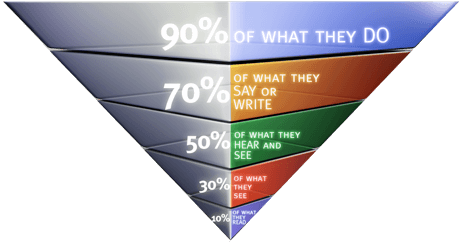 I hear, I forget.
I hear, I forget.
I see, I remember.
I DO, I UNDERSTAND.
– Confucius (551 BC – 479 BC)
Do you know how to jump rope? Imagine if you didn’t know anything about it and someone described it to you. You could probably repeat how to do it, if asked – though you’d forget the details, like knowing it’s time to jump as the rope comes over your head and passes your eyes or remembering how important it was to keep a steady pace.
Watching someone jump rope would help. You would see the rhythm of it and see that one doesn’t need to jump very high to be successful.
But DOING it – that’s another thing entirely. And if presented with a test at the end, outside of crazy luck, only the person who had picked up the rope and tried on his/her own would have ANY chance of jumping the rope successfully for a few minutes the first time around.
So then WHY is most training and learning based on the concept of ‘Show & Tell’ or even worse, sometimes just ‘Tell’? If something as simple as jumping rope needs to be practiced to be fully understood, what does that say for mission-critical Operations & Maintenance training?
Our customers often tell us “these PowerPoint’s and YouTube style how-to videos aren’t working, should we improve the graphics or shoot them in HD?”
No, you shouldn’t. You should stop wasting time on them at all, actually.
A common saying in the trenches of field operations is “If there is NO practice, there is NO training”. Till the students are able to perform the procedures themselves, retention is minimal.
And numerous studies offer similar results. When it comes to knowledge retention, people remember:

So, here’s how to make your training stick:
1. SHOW them what to do, don’t just tell them. Make it visual.
2. Make them DO it. (This is the most important step.)
3. TELL them how they did, what they did right/wrong and remedial solutions. The more visual the feedback, the better.
It’s as simple as that.
But live sessions on real equipment are expensive, hard to schedule and sometimes even dangerous. So what now?
“From learning by listening to learning by doing… Education and learning will become as much fun as videogames. And we call it ‘full body learning.”
– Bing Gordon, Partner, KPCB (arguably one of the most influential Venture Capitalist firms)
Heartwood’s 3D Interactive Training or also known as simulation-based training does ALL of the above. It empowers students to practice on virtual equipment (or Aircraft, Vehicle, Machinery, etc) that is replicated in form and function, allowing them to ‘learn by doing’ anytime, anywhere.
And it actually saves you money! (Read our post on the 3-Step Business Case)
Photo credit: Tomas Sobek on Flickr


